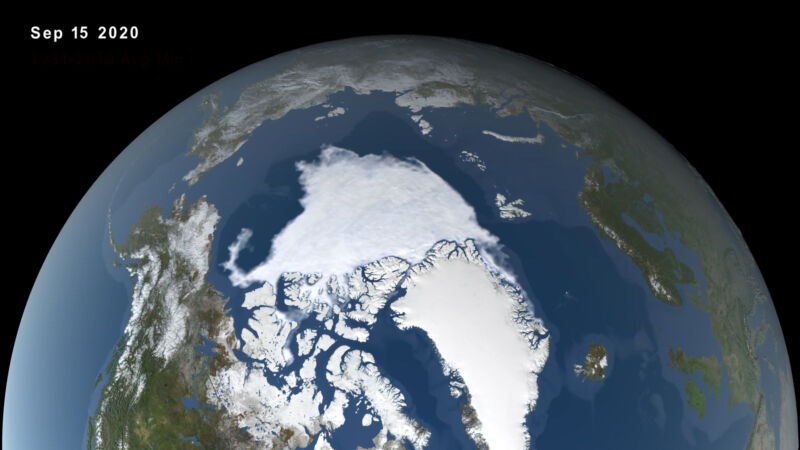
One sign of the transition from summer to fall in the Northern Hemisphere is the annual minimum point in Arctic sea ice extent. Last year tied 2016 and 2007 for second place behind 2012’s record-low coverage. But after another warm year on a warming planet, 2020 hit a lower mark and claimed the No.2 spot free and clear.
Sea ice is floating, frozen seawater, and so its melting does not materially contribute to sea level rise, unlike glacial ice on land. Sea ice coverage in both polar regions grows over the winter and shrinks over the summer. In the Arctic, losses bottom out and give way to growth in mid-September. Around this time of year, scientists watch satellite data carefully, waiting for several days of stability or slight growth to call the minimum.
That minimum likely occurred on September 15, according to the National Snow and Ice Data Center. (It’s possible that a weird turn of weather could cause the extent to drop again to a lower minimum in the next few days, but this probably wouldn’t change the numbers much.) The center put the minimum extent at 3.74 million square kilometers (1.44 million square miles).
For comparison, the average summer minimum between 1981 and 2010 was 6.25 million square kilometers. The record low in 2012 was 3.39 million square kilometers. Compared to 2012, 2020 saw more sea ice in the Beaufort Sea but less in the Laptev and East Greenland Seas.
The winter maximum extent back on March 5 was the 11th lowest on record and a bit higher than the last few years. But the melt season started with extreme warmth across Siberia, and sea ice extent dropped rapidly. In July, a new summer record looked like it could be on the way, but losses slowed in August, and another run in early September wasn’t quite enough to push past 2012.
-
Average summer minimum extent for 1981-2010 is shown with the yellow line.
-
Here’s how 2020’s minimum compares to 2012.
-
Here’s how extent has played out over 2020 (blue) compared to the record low (red) and the 1981-2010 average (gray).
-
This estimate of Arctic sea ice volume hasn’t yet been updated for September, but August was 3rd lowest.
Several metrics are used for sea ice, with extent representing the area of continuous coverage. But thickness and volume are also important. Sea ice that survives the summer tends to thicken over the following winter, but much less ice survives multiple years now. As a result, sea ice thickness has decreased. And that also means that the thinner ice can melt and disappear more quickly over the summer.
Total sea ice volume is estimated by the PIOMAS project. This is only updated monthly, so September is not included yet, but August volume was the third lowest on record.
At the other end of the world, Antarctic sea ice is approaching its winter maximum, which occurs a few weeks later. Extent there is looking like the highest since 2014’s satellite-era record and falls above the 1973-2019 average. Antarctic sea ice is considerably more variable from year-to-year and is not experiencing rapid decline like the Arctic. That’s because the Antarctic is experiencing less warming and because the sea ice has a frigid continent to grow around.
-
Here’s how 2020 stacks up with some recent years in the Antarctic.
-
Here’s what combining sea ice extent at both poles looks like, with 2020 shown in red, tracking near the bottom of the pack for September.
But for the Arctic, the National Snow and Ice Data Center notes, the 14 lowest summer sea ice extents in the satellite era have been… the last 14 years. Surface air temperatures in the Arctic are warming at about three times the global average, leading to profound climate, ecosystem, infrastructure, and even geopolitical impacts.
https://arstechnica.com/?p=1708726

